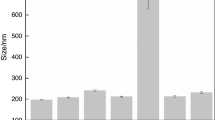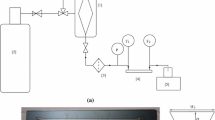Abstract
Particulate fouling studies with alumina dispersions in water were performed in rectangular, silicon microchannels having hydraulic diameters between 220 and 225 μm with Reynolds numbers of 17–41. Data show for the most part the absence of particle deposition within the microchannels. The primary reason for this is the relatively high wall shear stress at the microchannel walls of 2.3–3.5 Pa compared to conventional size passageways. In contrast, the headers for the microchannels are quite susceptible to particulate fouling under the same conditions. This is because the shear stress in the header region is lower. Proper adjustment of pH has been identified to effectively mitigate the fouling by controlling the electrostatic forces of repulsion between particle–particle interactions.



















Similar content being viewed by others
Notes
Velocity magnitude is defined as: \( V_{{{\text{mag}}}} = {\sqrt {V^{2}_{x} + V^{2}_{y} } }, \) V x and V y are the velocities in the x and y directions respectively. V x and V y are perpendicular and parallel respectively to the channel entrances in the header region.
The gravitational force was based on the bulk density of the alumina particles. When aggregates grow there is a decrease in the aggregate density. Even if the density was reduced by a factor of 2 the gravitational force would still be eight times greater than the lift force in the header region.
An approximate value for the energy barrier is given because the scaled separation distance, κa, for the 248-nm particles is only 1.04 at pH 9.0 and 1.69 at pH 9.5. At such a low value of κa the curvature of the surface elements will become important between the two interacting particles and Derjaguin’s approximation loses its accuracy, which was used in the derivation of Eqs. 14 and 15.
Abbreviations
- a :
-
particle radius (m)
- A 132 :
-
Hamaker constant (J)
- b :
-
half channel width (m)
- c :
-
half channel height (m)
- d, d p :
-
particle diameter (m)
- D h :
-
hydraulic diameter (m)
- e :
-
elementary electric charge (coulomb)
- E el :
-
electrostatic interaction energy (J)
- E t :
-
total interaction energy (J)
- E vdw :
-
van der Waals interaction energy (J)
- F el :
-
electrostatic force (N)
- F g :
-
gravitational force (N)
- F L :
-
lift force (N)
- F T :
-
total force (N)
- F vdw :
-
Van der Waals force (N)
- g :
-
acceleration due to gravity (m/s2)
- H :
-
minimum separation distance (m)
- J B :
-
collision rate due to Brownian motion (1/s)
- J S :
-
collision rate due to shear (1/s)
- k :
-
Boltzmann constant (J/K)
- m, n :
-
exponents (unitless)
- n*:
-
electrolyte concentration (atom or molecule per m3)
- Re :
-
Reynolds number (unitless)
- R ij :
-
collision radius of particles i and j (m)
- R p :
-
particle radius (m)
- s :
-
half fin width (m)
- T :
-
absolute temperature (K)
- u, U :
-
velocity (m/s)
- u m :
-
mean velocity (m/s)
- u max :
-
maximum velocity (m/s)
- y, z :
-
distance from surface (m)
- z*:
-
electrolyte valance charge (unitless)
- αc*:
-
channel aspect ratio (unitless)
- δ*:
-
parameter in determining zeta potential (unitless)
- εo :
-
dielectric permittivity of vacuum (F/m)
- εr :
-
relative dielectric constant of medium (unitless)
- κ:
-
Debye–Hückel parameter (1/m)
- 1/κ:
-
Debye length or diffuse layer thickness (m)
- λ:
-
wavelength (m)
- λc :
-
characteristic wavelength of interaction (m)
- μE :
-
electrophoretic mobility (m2/V s)
- μf :
-
viscosity of fluid (kg/m s)
- ρf :
-
density of fluid (kg/m3)
- ρp :
-
density of particle (kg/m3)
- τw :
-
Shear stress at wall (Pa)
- ψs :
-
surface potential (V)
- ζ:
-
zeta potential (V)
References
Abulnaga BE (2002) Slurry systems handbook, chap 9. McGraw-Hill, New York
Benzinger U et al (2005) Anti fouling investigations with ultrasound in a microstructured heat exchanger. In: Proceedings of the 6th international conference on heat exchanger fouling and cleaning challenges and opportunities. Kloster Irsee, Germany
Bergendahl J, Grasso D (2000) Prediction of colloid detachment in a model porous media: hydrodynamics. Chem Eng Sci 55:1523–1532
Bowen BD, Epstein N (1979) Fine particle deposition in smooth parallel-plate channels. J Colloid Interface Sci 72:81–90
Dabroś T et al (1983) Direct method for studying particle deposition onto solid surfaces. Colloid Polym Sci 261:694–707
Derjaguin BV, Landau LD (1941) Theory of the stability of strongly charged lyophobic sols and the adhesion of strongly charged particles in solutions of electrolytes, Acta Physicochim URSS 14:633–662
Grande WJ et al (1987) One-step two-level etching technique for monolithic integrated optics. Appl Phys Lett 51:2189–2191
Gregory J (1981) Approximate expressions for retarded van der Waals interaction. J Colloid Interface Sci 83:138–145
Hogg R, Healy TW, Fuerstenau DW (1966) Mutual coagulation of colloidal dispersions. Trans Faraday Soc 62:1638–1651
Holmberg K (2001) Handbook of applied colloid & surface chemistry, Chaps. 9, 10. Wiley, New York
Hu T (2004) Slurry flow control: improving yield rates on existing CMP tools. Cleanrooms mag, vol 18, issue 4, April 2004. Available at http://cr.pennnet.com/display_article/203332/15/ARTCL/none/none/1/Slurry-flow-control:-Improving-yield-rates-on-existing-CMP-tools/
Hubbe MA (1984) Theory of detachment of colloidal particles from flat surfaces exposed to flow. Colloids Surf 12:151–178
Kakaç S (1987) Handbook of single-phase convective heat transfer, chap 3. Wiley, New York
Kern W (1993) Handbook of semiconductor wafer cleaning technology: science, technology, and applications, chap 4. Noyes Publications, Berkshire
Leighton D, Acrivos A (1985) The lift on a small sphere touching a plane in the presence of a simple shear flow. J Appl Math Phys (ZAMP) 36:174–178
Marshall JS (2007) Particle aggregation and capture by walls in a particulate aerosol channel flow. J Aerosol Sci 38:333–351
Meinhart CD, Wereley ST, Gray MHB (2000) Volume illumination for two-dimensional particle image velocimetry. Meas Sci Technol 11:809–814
Niida T, Kousaka Y, Furukawa T (1989) Removal of adhering particles of polystyrene latex and iron oxide on a wall by shear flow in water, Particle and Particle. Syst Charact 6:69–73
Ohshima H (1994) Simple expression for Henry’s function for the retardation effect in electrophoresis of spherical colloidal particles. J Colloid Interface Sci 168:269–271
Ohshima H, Healy TW, White LR (1982) Improvement on the Hogg-Healy-Fuerstenau Formulas for the interaction of dissimilar double layers. J Colloid Interface Sci 89:484–493
O’Neill ME (1968) A sphere in contact with a plane wall in a slow linear shear flow. Chem Eng Sci 23:1293–1298
Perry JL (2007) Fouling and its mitigation in silicon microchannels used for IC chip cooling. PhD thesis, Rochester Institute of Technology, Rochester
Seidel H et al (1990) Anisotropic etching of crystalline silicon in alkaline solutions-I. Orientation dependence and behavior of passivation layers. J Electrochem Soc 137:3612–3626
Snoswell D et al (2005) Colloid stability of synthetic titania and the influence of surface roughness. J Colloid Interface Sci 286:526–535
Steinke ME (2005) Single-phase liquid flow and heat transfer in plain and enhanced silicon microchannels. PhD. thesis, Rochester Institute of Technology, Rochester
Van de Ven T (1989) Colloidal hydrodynamics, chap 1. Academic Press, New York
Verwey EJW, Overbeek J Th G (1948) Theory of the stability of lyophobic colloids. Elsevier, Amsterdam
Yiantsios SG, Karabelas AJ (1995) Detachment of spherical microparticles adhering on flat surfaces by hydrodynamic forces. J Colloid Interface Sci 176:74–85
Yiantsios SG, Karabelas AJ (1998) The effect of gravity on the deposition of micron-sized particles on smooth surfaces. Int J Multiph Flow 24:283–293
Yiantsios SG, Karabelas AJ (2003) Deposition of micron-sized particles on flat surfaces: effects of hydrodynamic and physicochemical conditions on particle attachment efficiency. Chem Eng Sci 58:3105–3113
Acknowledgments
The authors are thankful for the support of the Microsystems program and Thermal Analysis and Microfluidics Laboratory at the Rochester Institute of Technology. The second author acknowledges the IBM Faculty Award in support of this work.
Author information
Authors and Affiliations
Corresponding author
Rights and permissions
About this article
Cite this article
Perry, J.L., Kandlikar, S.G. Fouling and its mitigation in silicon microchannels used for IC chip cooling. Microfluid Nanofluid 5, 357–371 (2008). https://doi.org/10.1007/s10404-007-0254-4
Received:
Accepted:
Published:
Issue Date:
DOI: https://doi.org/10.1007/s10404-007-0254-4




